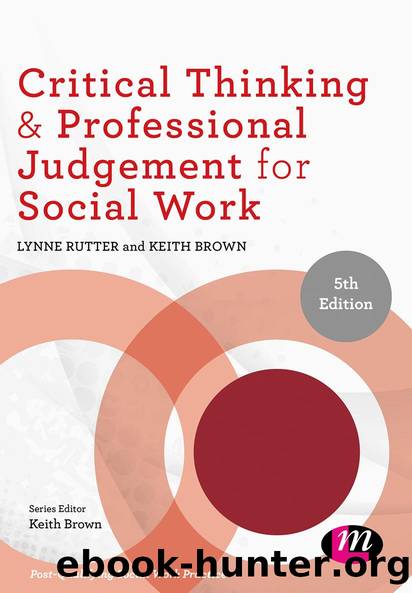Critical Thinking and Professional Judgement for Social Work by Lynne Rutter Keith Brown

Author:Lynne Rutter, Keith Brown [Lynne Rutter, Keith Brown]
Language: eng
Format: epub
Tags: Social Science, Social Work
ISBN: 9781526466983
Google: o9qyDwAAQBAJ
Publisher: Learning Matters
Published: 2019-09-30T05:18:54+00:00
Reflection Point
What additional questions could be, or would need to be, asked at each level in the framework above?
How would you recognise particular barriers to deep reflection that come from a lack of awareness of your role in what occurred, e.g. denial, blinkered views, limited perspective, lack of empathy?
We know that we will, at times, experience strong feelings or inherent beliefs that affect our behaviour and limit our responses to a situation. We need to be able to reflect deeply enough to become aware of these limiting factors in order to be able to address them accordingly. Of course, this is not an easy task but it does lead to more meaningful learning. Korthagen and Vasalos (2005) call it âcore reflectionâ. Their ALACT model (Action; Looking back on action; Awareness of essential aspects; Creating alternative methods of action; Trial) also provides a structured reflection process, but they combine it with an âonion modelâ that deals with the content and underlying issues of that process (from the outer environment and organisation down through levels of behaviour, competences, beliefs and identity towards a central mission). The emphasis here is on identifying and dealing with the limiting factors that prevent achievement of an ideal situation. These could be located on any number of levels within the onion. For example, the authors identify the ways in which a practitioner may be limiting themselves with their behaviour (avoiding confrontation), feelings (of powerlessness) and beliefs (that this is something I have no influence over). By formulating the ideal situation, together with the factors experienced as inhibiting the achievement of that ideal, the person becomes aware of an inner tension or discrepancy. The point is that once the limiting factors are recognised we have a choice over whether or not to allow them to determine our behaviour â if we reflect in this way, we can start to ask some fundamental questions with regard to such choices. The authors also identify a need for core qualities or character strengths to become mobilised in response here, e.g. creativity, courage, kindness, fairness. Their examples focus on a teaching environment, but again, the essential features relate on a human level to all of us.
Core reflection like this will, therefore, challenge deep and personally held beliefs, assumptions or inner values. When this happens you will need the extra support of someone you trust to help you deal with it, so it is important you recognise this as soon as it starts to happen. The need for safe and facilitated/supported learning environments therefore becomes essential to help actualise such qualities and enable an awareness of new possibilities for action. The notion of reflective supervision is explored further in Williams and Rutter (2019) and Howe and Gray (2013).
Download
This site does not store any files on its server. We only index and link to content provided by other sites. Please contact the content providers to delete copyright contents if any and email us, we'll remove relevant links or contents immediately.
Cecilia; Or, Memoirs of an Heiress — Volume 1 by Fanny Burney(32503)
Cecilia; Or, Memoirs of an Heiress — Volume 2 by Fanny Burney(31913)
Cecilia; Or, Memoirs of an Heiress — Volume 3 by Fanny Burney(31900)
The Great Music City by Andrea Baker(31759)
We're Going to Need More Wine by Gabrielle Union(19004)
All the Missing Girls by Megan Miranda(15788)
Pimp by Iceberg Slim(14438)
Bombshells: Glamour Girls of a Lifetime by Sullivan Steve(14024)
For the Love of Europe by Rick Steves(13641)
Talking to Strangers by Malcolm Gladwell(13300)
Norse Mythology by Gaiman Neil(13284)
Fifty Shades Freed by E L James(13189)
Mindhunter: Inside the FBI's Elite Serial Crime Unit by John E. Douglas & Mark Olshaker(9266)
Crazy Rich Asians by Kevin Kwan(9225)
The Lost Art of Listening by Michael P. Nichols(7456)
Enlightenment Now: The Case for Reason, Science, Humanism, and Progress by Steven Pinker(7275)
The Four Agreements by Don Miguel Ruiz(6704)
Bad Blood by John Carreyrou(6586)
Weapons of Math Destruction by Cathy O'Neil(6220)
